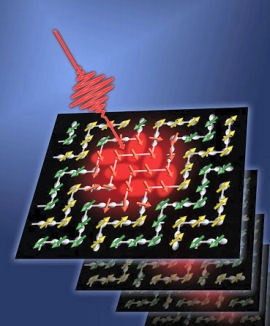4 April 2013
Quantum tricks turbocharge magnetic storage
by Will Parker
 Researchers have found a new way to switch magnetism that is at least 1,000 times faster than methods currently used in magnetic memory technologies. The discovery, reported in Nature, potentially opens the door to terahertz (1012 hertz) and faster memory speeds. The research team comprised scientists from the U.S. Department of Energy's Ames Laboratory, Iowa State University, and the University of Crete in Greece.
Researchers have found a new way to switch magnetism that is at least 1,000 times faster than methods currently used in magnetic memory technologies. The discovery, reported in Nature, potentially opens the door to terahertz (1012 hertz) and faster memory speeds. The research team comprised scientists from the U.S. Department of Energy's Ames Laboratory, Iowa State University, and the University of Crete in Greece.
In current magnetic storage devices and magneto-optical recording technology, magnetic fields or continuous laser light is used to switch magnetic states. For example, photo-excitation causes atoms in ferromagnetic materials to heat up and vibrate, and the vibration, with the help of a magnetic field, causes magnetic flips. The flips are how information is encoded.
"But the speed of such thermal magnetic switching is limited by how long it takes to vibrate the atoms, and by how fast a magnetic field can reverse magnetic regions," explained Ames Laboratory physicist Jigang Wang. "And it is very difficult to exceed the gigahertz (109 hertz) switching speed limit of today's magnetic writing/reading technology."
To overcome this barrier, scientists are turning their attention to colossal magnetoresistive (CMR) materials that are highly responsive to the external magnetic fields used to write data into memory, but do not require heat to trigger magnetic switching.
Wang and his team report how they used short laser pulses to create ultra-fast changes in the magnetic structure, within quadrillionths of a second (femtosecond) in CMR materials.
"In one CMR manganite material, the magnetic order is switched during the 100-femtosecond-long laser pulse. This means that switching occurs by manipulating spin and charge quantum mechanically," explained Wang.
According to Wang, the fast switching speed and huge magnetization meet both requirements for applying CMR materials in ultra-fast, terahertz magnetic memory and logic devices.
"Our strategy is to use all-optical quantum methods to achieve magnetic switching and control magnetism. This lays the groundwork for seeking the ultimate switching speed and capabilities of CMR materials, a question that underlies the entire field of spin-electronics," said Wang. "And our hope is that this means someday we will be able to create devices that can read and write information faster than ever before, yet with less power consumed."
Related:
Discuss this article in our forum
Physicists explore negative entropy in computation
Moore's Law No More?
Memory And Computation Set For Cohabitation
Mushy memory brings biocompatible electronics a step closer
Source: Ames Laboratory
